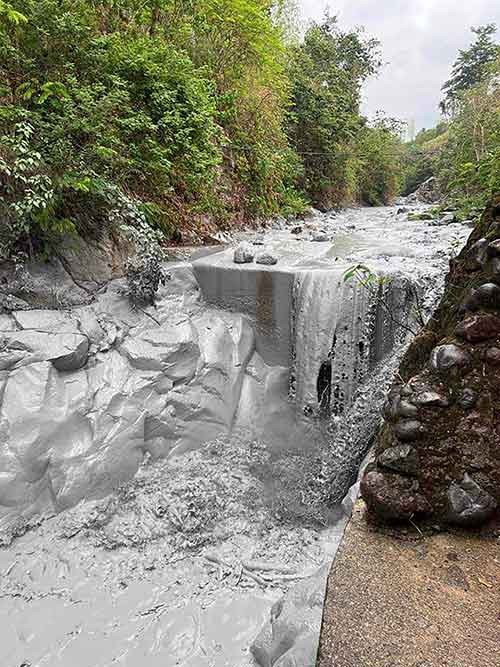
By Glazyl Y. Masculino and Dolly Yasa
BACOLOD CITY—The Philippine Institute of Volcanology and Seismology (Phivolcs) has alerted some areas on Negros Island for possible lahars, as moderate to heavy rains from localized thunderstorms have been forecast by the Philippine Atmospheric Geophysical and Astronomical Services Administration (PAGASA) over Kanlaon Volcano in Canlaon City, Negros Oriental, on Thursday, June 6.
In its lahar advisory at 12 a.m. on Thursday, Phivolcs stated that these rains could generate muddy streamflow or muddy runoff from rivers draining the southern Mt. Kanlaon edifice, which could threaten communities along the middle and lower slopes with inundation, burial, and washout.
Phivolcs reported that lahars have been noted by netizens on various social media posts and were verified by their Quick Response Team (QRT) on the field.
Grey cohesive mud, plant debris, and gravel have been deposited by lahars in at least four waterways: Tamburong Creek, which courses through Barangays Biak-na-Bato and Calapnagan in La Castellana town; upstream Baji-Baji Falls in Barangay Cabacungan, also in La Castellana; Intiguiwan River in Barangay Guinpanaan, Moises Padilla town, both in Negros Occidental; and Padudusan Falls in Barangay Masulog, Canlaon City, and the Binalbagan River, which drains the southern flank of Kanlaon Volcano, according to Phivolcs.
The lahars were generally channel-confined but flows along Tamburong Creek overflowed and dumped a few centimeters of deposit on a stretch of the main road in Biak-na-Bato, rendering it impassable to motorists.
Thunderstorms early Wednesday generated volcanic sediment flows or lahars on the southern slopes that were detected by three seismic stations of the Kanlaon Volcano Network (KVN), Phivolcs reported.
These lahars began around 1 p.m. and lasted 25 minutes based on the seismic record.
A total of 23.75 mm of rain over a two-hour period was recorded by the All-Weather Station of the Manghumay, Barangay Mailum, Bago City Observation Station (VKMH) of the KVN. Higher rainfall volumes may have occurred around the summit area of the volcano.
With these circumstances, Phivolcs strongly recommended increased vigilance and readiness of communities along rivers draining southern Kanlaon. Phivolcs advised these communities and local government units to continually monitor weather conditions and take preemptive response measures for their safety from potential lahars.
The lahar prompted La Castellana town to impose a forced evacuation in some sitios of Barangay Biak-na-Bato for safety. More than 1,000 residents were evacuated since the eruption on Monday night.
As of Thursday afternoon, roads in Barangay Biak-na-Bato are now passable, but the local government of La Castellana advised motorists to take extra precaution due to slippery roads from the lahar.
The lahar washed away by heavy rains on Wednesday came from ashes and debris of rocks from the eruption of Kanlaon Volcano on Monday night.
La Castellana Mayor Rhummyla Nicor Mangilimutan said that Alert Level 3 is being considered in some upper barangays of the town following the Kanlaon volcano eruption on Monday.
Alert Level 3 signifies an “increased tendency towards a hazardous eruption” and follows the “increasing unrest” under Alert Level 2, which was declared on Monday, June 4.
Mangilimutan, along with Governor Eugenio Jose Lacson, Vice Governor Jeffrey Ferrer, and Mayors Rex Jalando-on of La Carlota City, Jose Maria Alonso of Pontevedra, Gerry Rojas of Murcia, and Nico Yulo of Bago City, met with PHIVOLCS representatives and other concerned government agencies to coordinate disaster response efforts related to the mudflow that affected some LGUs due to rain washing out volcanic debris.
“We are considering raising Alert Level 3 in some areas,” Mangilimutan told the Daily Guardian in a phone interview.
She noted that the number of evacuees increased to more than 1,100 after lahar triggered by heavy rains flowed down the slopes of Kanlaon volcano, impacting roads, creeks, rivers, and some households.
The mayor added that she will meet with the local disaster coordinating council to identify the affected areas.
She highlighted the urgent need for water, medicines, and facemasks for the affected individuals.
The town was placed under Alert Level 2 after the Kanlaon volcano eruption on Monday.
‘SCAMS’
Meanwhile, the city government of Canlaon in Negros Oriental urged the public to be cautious of potential scams following the rise in donation drives for the eruption victims.
In a statement, the local government clarified that they are not involved with any personal donation drives, stressing that the local government, together with provincial, regional, and national agencies, particularly the Department of Social Welfare and Development (DSWD), has sufficient resources to address the needs of affected residents.
The city government said their collaborative efforts ensure that relief and support are adequately provided to those in need.
Assistance from government and private organizations has been pouring in for the victims since the volcano erupted on Monday night, June 3. This is the most recent volcanic activity of Mt. Kanlaon, nearly seven years after its last eruption in December 2017.
To avoid any misuse of the calamity situation for fraudulent activities, the local government stated that donations and support for the victims can be directed to the city government through the Incident Command System for proper guidance, coordination, and acknowledgment.
Meanwhile, Mayor Jose Cardenas declared the suspension of work in government and private offices in Canlaon City on Thursday, June 6, due to the volcanic unrest.
“This is a precautionary and proactive measure in anticipation of any untoward incident,” Cardenas said in the executive order.




















